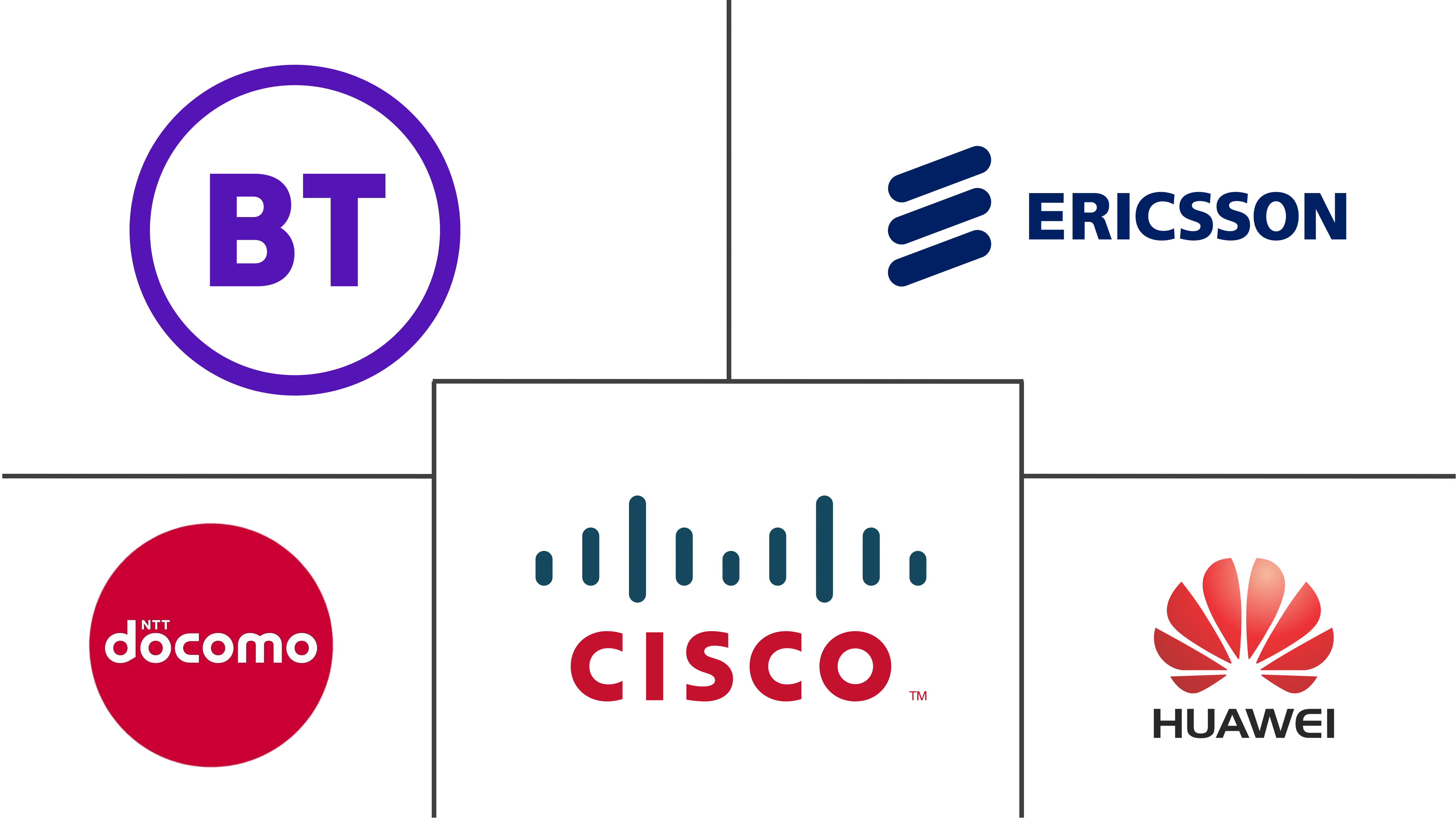Network Slicing Market Size and Share
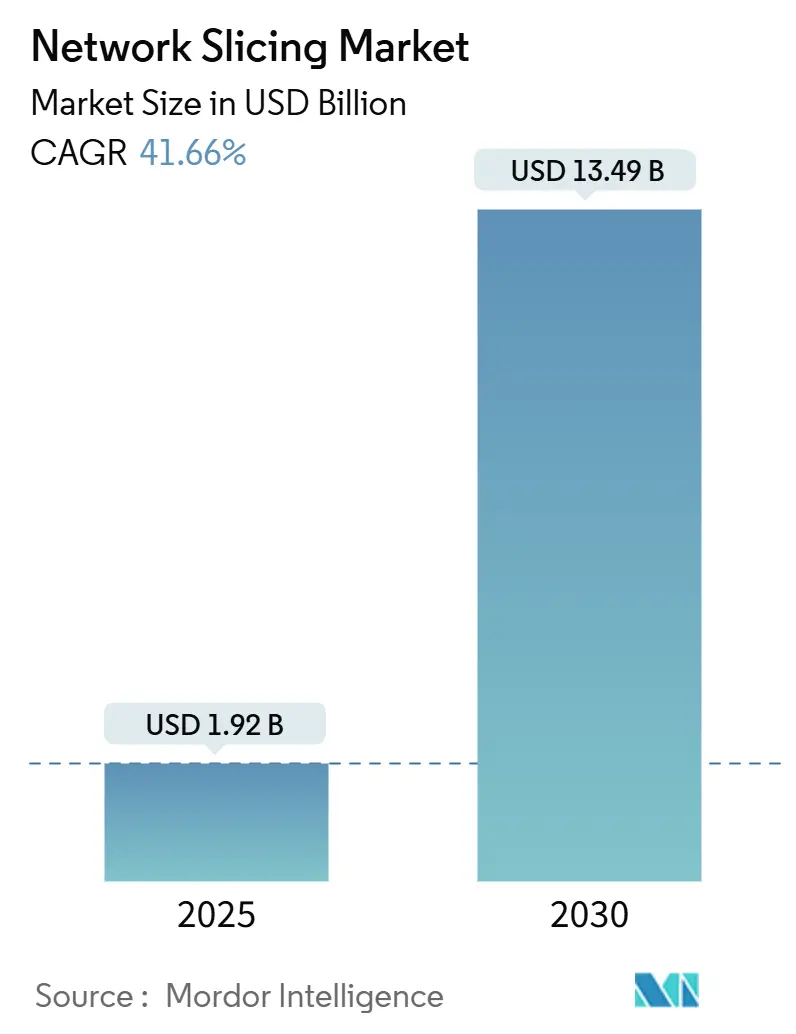
Network Slicing Market Analysis by Mordor Intelligence
The Network Slicing Market size is estimated at USD 1.92 billion in 2025, and is expected to reach USD 13.49 billion by 2030, at a CAGR of 41.66% during the forecast period (2025-2030).
The shift from best-effort connections to programmable, service-differentiated networks is the prime catalyst, enabling communication service providers (CSPs) to monetize 5G standalone (SA) investments through virtual network segments with guaranteed service levels. Rapid 5G SA roll-outs, the need for ultra-reliable low-latency communication (URLLC) in Industry 4.0 plants, and the appeal of slice-as-a-service models are accelerating adoption. Competitive intensity is rising as infrastructure vendors, cloud-native software specialists, and hyperscalers race to deliver orchestration platforms that automate slice life-cycle management. Supply-chain constraints persist, notably 56-week semiconductor lead times, yet operators continue to prioritize software investments to capture developer-led revenue streams through network-as-code APIs.
Key Report Takeaways
- By component, software captured 45.50% of the network slicing market share in 2024; infrastructure software is advancing at a 44.25% CAGR through 2030.
- By service model, managed services commanded a 55.45% share of the network slicing market size in 2024, while network-as-a-service exhibits a 42.36% CAGR to 2030.
- By application, remote monitoring held 36.72% of the network slicing market in 2024; mobile cloud gaming is projected to grow at a 44.79% CAGR through 2030.
- By end-user industry, automotive & transportation led with 28.22% of network slicing market share in 2024; media & entertainment is expanding at a 43.52% CAGR through 2030.
- By geography, North America accounted for 34.92% of the network slicing market in 2024, whereas Asia Pacific is forecast to post a 42.22% CAGR over 2025-2030.
Global Network Slicing Market Trends and Insights
Drivers Impact Analysis
| Driver | (~) % Impact on CAGR Forecast | Geographic Relevance | Impact Timeline |
|---|---|---|---|
| 5G SA roll-outs accelerating CSP demand shift | +12.50% | Global – led by North America and China | Medium term (2-4 years) |
| Enterprise private-network demand for URLLC & eMBB slices | +10.20% | North America & EU, expanding to Asia Pacific | Short term (≤ 2 years) |
| Edge-cloud convergence for dynamic slice orchestration | +8.70% | Global – concentrated in dense urban markets | Medium term (2-4 years) |
| CSP monetization urgency amid ARPU stagnation | +6.80% | Global – most acute in mature subscriber markets | Short term (≤ 2 years) |
| Source: Mordor Intelligence | |||
5G SA Roll-Outs Accelerating CSP Demand Shift
Standalone 5G architecture unlocks full network slicing capabilities, letting operators spin up isolated logical networks with guaranteed service levels that legacy cores cannot provide. Japan reached 98% 5G base-station coverage in designated areas by April 2024, spurring SA upgrades and signaling a global pivot toward slicing-ready infrastructure. Ericsson’s alliance with 12 tier-one operators targets a USD 30 billion network-API market by 2030, relying on slicing as the foundation for programmability[1]Akanksha Paliwal, “Telecom operators, vendors eye USD 30 billion network API opportunity,” reuters.com. T-Mobile’s hybrid private-5G-plus-slicing deployment for emergency medical data shows how differentiated connectivity can be commercialized quickly.
Enterprise Private-Network Demand for URLLC & eMBB Slices
Industrial companies view slicing as the most economical route to deterministic connectivity. In Italy, Ericsson, TIM, and Comau synchronized robots with digital twins using sub-10 ms slices, proving operational gains in predictive maintenance and remote AR support. South Korea allocated private 5G spectrum to 56 sites by February 2024, illustrating regulator support for enterprise-run infrastructure that relies on slice isolation.
Edge-Cloud Convergence Enabling Dynamic Slice Orchestration
AI-driven orchestration platforms now instantiate slices on demand, optimizing radio, transport, and core resources. VMware’s Telco Cloud Automation exemplifies 3GPP-compliant management that merges edge clusters with central clouds. Research shows deep-reinforcement learning cuts end-to-end latency by 25%, hinting at predictive slice management in dense deployments. Malaysia’s first 5G live sports broadcast leveraged an edge-enabled slice to secure bandwidth and sub-25 ms latency for real-time production.
CSP Monetization Urgency Amid ARPU Stagnation
As voice and data commoditize, CSPs treat slicing as a premium upsell path. Asia-Pacific 5G revenue is projected to surpass USD 130 billion by 2030, a milestone reachable only if operators commercialize differentiated latency tiers and network APIs. Verizon’s Frontline Network Slice for public safety, launched in 2025, demonstrates a willingness to pay for dedicated resources[2]Mike Dano, “Verizon turns on Frontline network slice in LA, Chicago,” lightreading.com. Singtel extended consumer slices with enhanced security to 1.5 million subscribers in 2024, proving mass-market addressability.
Restraints Impact Analysis
| Restraint | (~) % Impact on CAGR Forecast | Geographic Relevance | Impact Timeline |
|---|---|---|---|
| Low 5G penetration & device readiness | -8.40% | Emerging APAC, Middle East & Africa, Latin America | Medium term (2-4 years) |
| Multi-domain orchestration complexity & OPEX | -6.70% | Global – greater strain on smaller CSPs | Short term (≤ 2 years) |
| Source: Mordor Intelligence | |||
Low 5G Penetration and Device Readiness in Emerging Economies
Network slicing demands widespread SA coverage plus handsets able to select slices, yet Europe had only 2% SA coverage versus China’s 80% at end-2024. Delays in Indonesia’s 5G auctions illustrate how policy gaps can slow roll-outs, reducing operator incentive to invest in slice platforms.
Multi-Domain Orchestration Complexity and OPEX Burden
Only 15% of operators have an operational slicing platform because cross-vendor integration drives OPEX 30-50% higher than legacy management. Smaller carriers face capex pressure to modernize OSS/BSS stacks with open APIs, prompting a tilt toward managed-service partners able to shoulder orchestration workload.
Segment Analysis
By Component: Software Dominance Drives Automation
Software held a 45.50% share of the network slicing market in 2024 and is growing at a 44.25% CAGR, thanks to operator focus on orchestration, assurance, and security tooling. The network slicing market size derived from software platforms is projected to exceed USD 6 billion by 2030 alongside radio-agnostic control logic. Vendors differentiate through intent-based policy engines that adjust slice bandwidth in real time. Security modules that isolate tenant traffic and validate slice integrity are now baked into catalogues rather than sold as add-ons, lowering time to market and supporting multitenant monetization. Infrastructure hardware remains essential for 5G SA cores, yet its growth lags as CSPs sweat existing RAN assets while directing new funds to automated slice management. Transport upgrades continue, spurred by the need to guarantee deterministic latency across microwave, fiber, and IP/MPLS links.
Operators evaluating total cost of ownership favor disaggregated infrastructure with open interfaces, allowing cloud-native network functions to reside on commodity servers. This pivot moderates capex peaks and accelerates software uptake, reinforcing the central role of automation in the network slicing market. Multi-access edge computing (MEC) nodes embedded in metro data centers further extend software’s reach, enabling localized slice instantiation for latency-sensitive workloads.
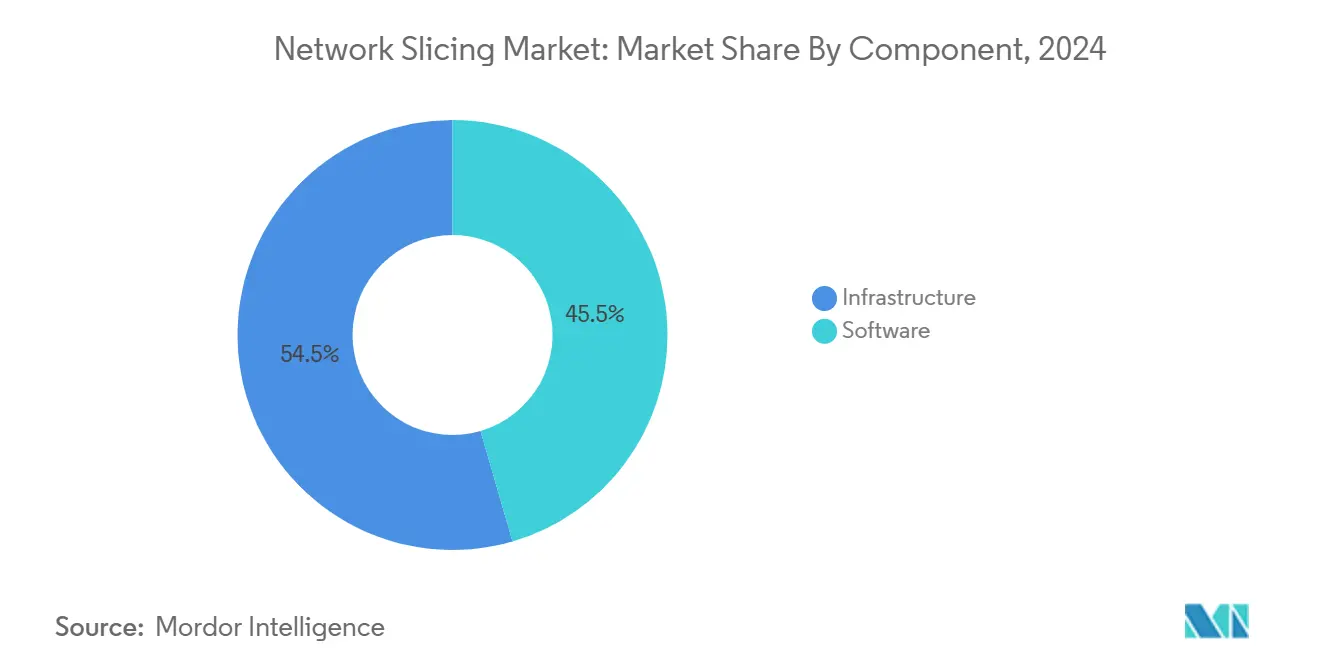
By Service: Managed Services Lead Enterprise Adoption
Managed services controlled 55.45% of the network slicing market share in 2024 and should post a 42.36% CAGR, reflecting enterprise preference for turnkey slice-as-a-service offerings. Vendor-operated portals now let IT managers request slices on demand, set quality-of-service tiers, and receive usage-based billing. The network slicing market size tied to managed services will likely surpass USD 7 billion by 2030 as CSPs bundle security and edge compute with connectivity. Network-as-a-service (NaaS) variants appeal to mid-market firms lacking in-house spectrum expertise, while government agencies adopt managed slices for public-safety footage, benefiting from sovereign data-hosting guarantees.
Professional services, including consulting, integration, and testing, serve as on-ramps for complex adoption cycles. Systems integrators align slice orchestration with enterprise SD-WAN, ERP, and IoT platforms, de-risking deployment. Proof-of-concept labs validate throughput and latency targets before commercial cut-over, reducing uncertainty for mission-critical use cases such as surgical robotics or real-time quality inspection.
By Application: Gaming Disrupts Traditional Monitoring Leadership
Remote monitoring maintained a 36.72% share of the network slicing market in 2024, driven by smart-factory cameras and utility-grid sensors that need deterministic uplink capacity. Isolated slices keep telemetry flowing even during network congestion, avoiding production halts. Meanwhile, mobile cloud gaming is rising at a 44.79% CAGR; enthusiasts demand 60 fps gameplay at 1080p with sub-50 ms round-trip latency, conditions that slices guarantee. During BT trials, players on Nvidia GeForce NOW sustained 25 Mbps with no visible jitter, validating consumer-grade slice viability[3]Doug Mohney, “BT tests network slicing for 5G gaming with GeForce NOW,” ispreview.co.uk.
Network function virtualization and cloud RAN orchestration also harness slices to segment test-beds from live traffic, trimming new-service roll-out cycles. Industrial automation continues to push deterministic latency boundaries, justifying premium slice tiers that map to robotic safety protocols and time-sensitive networking frameworks.
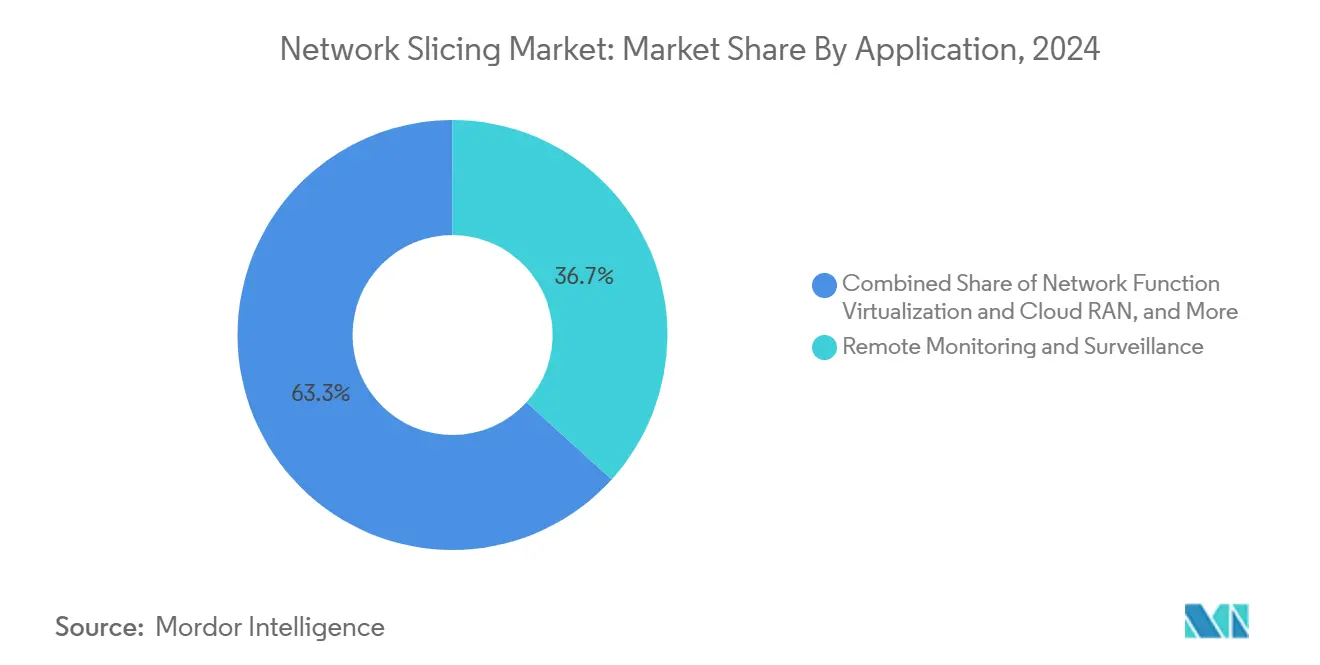
Note: Segment shares of all individual segments available upon report purchase
By End-User Industry: Media & Entertainment Accelerates Past Automotive
Automotive and transportation led with 28.22% of network slicing market share in 2024 as carmakers integrated vehicle-to-everything (V2X) modules requiring URLLC slices for collision avoidance. Fleet operators exploit enhanced mobile broadband slices to stream predictive maintenance data, cutting downtime across logistics corridors. Conversely, media & entertainment is forecast to grow 43.52% annually through 2030, overtaking automotive in slice spending. Private SA networks at stadiums already carry 4K wireless camera feeds, eliminating cable runs and enabling agile production. Ericsson and RTL Deutschland achieved 500 Mbps uplink with less than 25 ms latency during the 2024 European Football Championship, proving live event economics.
Healthcare adopts slices for telesurgery and ambulance telemetry, while power utilities secure grid-automation traffic against cyber threats via isolated VPN overlays. Aviation authorities test slices for baggage tracking and augmented reality wayfinding, foreshadowing broader airport digitization.
Geography Analysis
North America held a 34.92% share of the network slicing market in 2024, anchored by early 5G SA launches and permissive spectrum policies. CSPs such as T-Mobile expose slice order APIs nationwide, letting enterprises stitch private coverage into public footprints. Verizon’s Frontline Network Slice caters to first responders in Los Angeles and Chicago, generating incremental revenue via premium SLA tiers. Venture capital flows into orchestration start-ups, reinforcing an innovation loop that favors cloud-native design. Semiconductor shortages have lengthened radio unit lead times to 56 weeks, yet operators remain on schedule thanks to multi-vendor sourcing.
Asia Pacific is projected to deliver a 42.22% CAGR, the fastest regional pace, as China surpasses 2.28 million 5G sites and regulators expedite enterprise slice pilots[4]Tim Danks, “China tops 2.28 million 5G base stations,” huawei.com. Japan’s Ministry of Internal Affairs and Communications issues local 5 G licenses that let factories self-deploy SA networks; 72 demonstration projects now span smart ports, logistics hubs, and stadiums. South Korea allocates dedicated spectrum to 35 conglomerates, stimulating a supplier ecosystem around slice-aware devices and RAN automation.
Europe lags on SA coverage at 2%, constraining near-term slice revenues, yet policy is shifting. Seven nations opened the 26 GHz band for local 5G, and six permit up to 100 MHz in the 3.4-3.8 GHz band, enabling campus networks for manufacturing and research. The USD 20.28 billion Vodafone-Three UK merger pledges USD 14.86 billion in network upgrades by 2035, which should accelerate SA and slicing adoption. In the Middle East, European vendors pilot transport-network slicing with regional operators, validating architectures that may backfill Europe once spectrum and investment converge.
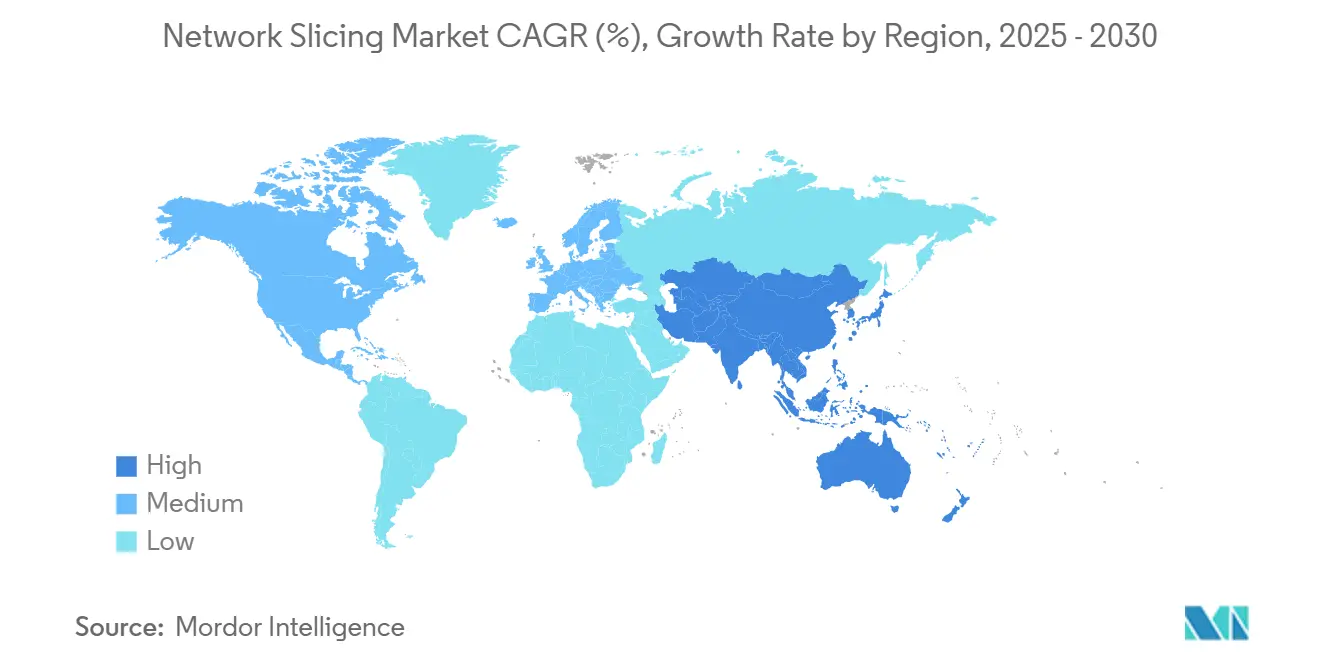
Competitive Landscape
Competition is moderately fragmented. Ericsson tops the Frost Radar for 5G infrastructure four years running and supplies end-to-end slicing from RAN to core, giving it an incumbency edge when CSPs pursue single-vendor accountability. Nokia controls roughly 55% of private-wireless contracts, positioning it to convert existing LTE campuses to 5G SA slices with minimal disruption. Samsung, Apple, and Qualcomm file slice-selection patents, embedding control logic into devices and expanding influence beyond modems.
Strategic alliances remake market boundaries. Ericsson’s 2024 joint venture with 12 global operators bundles network APIs, targeting USD 30 billion in revenue by 2030 and lowering entry barriers for software developers. Cloud hyperscalers partner with telcos to host 5G cores on distributed compute fabrics, offering latency guarantees through integrated slice orchestration. AI-native start-ups focus on intent-based engines that predict congestion and pre-allocate spectrum, achieving 25% latency gains in field tests. Over time, vendors that deliver multivendor automation and open APIs are likely to capture an outsized share as enterprises demand frictionless provisioning.
Network Slicing Industry Leaders
-
Ericsson Inc.
-
Huawei Technologies Co. Ltd
-
Cisco Systems Inc.
-
BT Group PLC
-
NTT DOCOMO Inc.
- *Disclaimer: Major Players sorted in no particular order
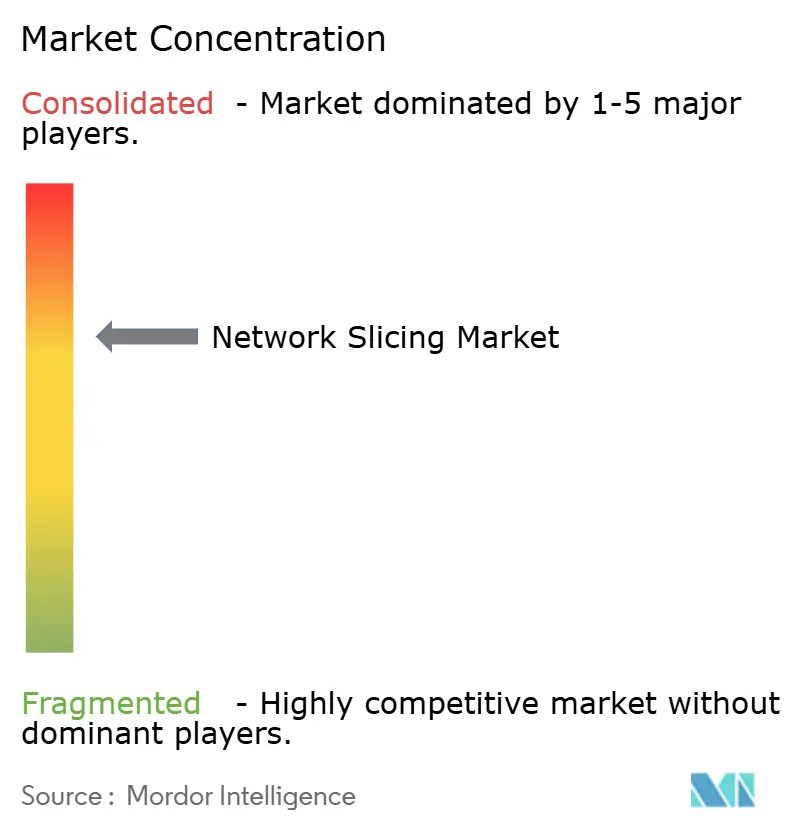
Recent Industry Developments
- June 2025: Verizon launched Frontline Network Slice for public safety in Los Angeles and Chicago.
- January 2025: Comarch and ITOCHU Techno-Solutions began building a virtualized 5G SA network for KDDI.
- December 2024: Ericsson completed an automated 5G slicing project with Orange Belgium, enabling real-time RAN partitioning.
- October 2024: Singtel extended 5G SA slicing to 1.5 million consumers via its 5G+ service.
Research Methodology Framework and Report Scope
Market Definitions and Key Coverage
Our study defines the network slicing market as the revenue generated from commercial 5G Stand-Alone slices provisioned across virtualized RAN, core, and transport domains to meet customer-specific service-level agreements. The model captures software licenses, slice-management services, and enabling infrastructure directly tied to slice creation and life-cycle management for public mobile networks.
Scope exclusion: legacy 2G/3G managed services, private campus Wi-Fi, and hardware sold for non-slice-aware 5G deployments remain outside the baseline.
Segmentation Overview
- By Component
- Infrastructure (RAN, Core, Transport)
- Software (MANO, Analytics, Security)
- By Service
- Professional (Consulting, Integration, Testing)
- Managed (Network-as-a-Service, Slice-as-a-Service)
- By Application
- Remote Monitoring and Surveillance
- Network Function Virtualization and Cloud RAN
- Mobile Cloud Gaming and Media Streaming
- Remote Industrial Automation (IIoT)
- By End-User Industry
- Healthcare
- Automotive and Transportation
- Power and Energy
- Aviation and Aerospace
- Media and Entertainment
- By Geography
- North America
- United States
- Canada
- Mexico
- Europe
- United Kingdom
- Germany
- France
- Spain
- Rest of Europe
- Asia-Pacific
- China
- Japan
- India
- South Korea
- Rest of Asia-Pacific
- Middle East and Africa
- United Arab Emirates
- Saudi Arabia
- South Africa
- Rest of Middle East and Africa
- South America
- Brazil
- Argentina
- Rest of South America
- North America
Detailed Research Methodology and Data Validation
Primary Research
Mordor analysts interviewed network architects at operators across North America, Europe, and Asia-Pacific, as well as procurement heads from automotive, healthcare, and media enterprises. These discussions validated realistic adoption rates, average slice pricing, and the expected timeline for ultra-reliable low-latency slices.
Desk Research
During desk work, we relied on freely available tier-1 sources such as 3GPP release notes, GSMA Intelligence deployment trackers, ITU spectrum databases, FCC and Ofcom filings, and industry association white papers, which offered dependable counts on 5G SA launches and spectrum allocations. National statistics portals, for example, the US Bureau of Labor Statistics and Eurostat, helped us size vertical demand pools, while patent analytics from Questel signaled vendor intensity and technology focus. Company 10-Ks, investor decks, and press announcements accessed through Dow Jones Factiva clarified rollout timelines. Volza shipment ledgers indicated gNodeB volumes, and peer-reviewed journals explained spectrum-utilization gains that underpin volume estimates. This list is illustrative, not exhaustive.
Market-Sizing & Forecasting
We begin with a top-down demand pool built from country-level 5G SA subscribers, traffic profiles, and addressable enterprise sites. We then refine slice-penetration assumptions with interview insights. Select bottom-up checks, sample vendor revenue roll-ups, and verified slice contracts align totals. Key variables include 5G base-station additions, spectrum-auction spend, NFV penetration, ARPU uplift linked to premium slices, and industrial IoT device counts. A multivariate regression blended with scenario analysis projects each driver to 2030. Missing vendor disclosures are bridged through regional channel checks and conservative interpolation.
Data Validation & Update Cycle
Outputs pass variance tests, peer review, and anomaly triggers. Models refresh annually, with interim updates after material events. Before delivery, an analyst performs a fresh sweep so clients receive the latest calibrated view.
Why Mordor's Network Slicing Baseline Earns Trust
Published estimates often diverge because definitions, pricing curves, and refresh cadences vary.
Key gap drivers include the inclusion of private 5G revenue by some publishers, flat pricing across regions, mixed-year currency conversions, and longer update cycles. Mordor Intelligence reports only public 5G SA slices, applies contract-verified pricing, converts at uniform 2025 FX rates, and revisits the model each year.
Benchmark comparison
| Market Size | Anonymized source | Primary gap driver |
|---|---|---|
| USD 1.92 B (2025) | Mordor Intelligence | - |
| USD 1.30 B (2025) | Regional Consultancy A | Excludes slice-management services; uses flat pricing curve. |
| USD 1.95 B (2025) | Trade Journal B | Blends private 5G and public slices in scope. |
| USD 1.68 B (2025) | Industry Association C | Applies 2024 FX rates and a two-year refresh cycle. |
The comparison shows that once consistent scope, pricing logic, and currency treatment are applied, our figure offers a balanced, transparent starting point that decision-makers can depend on.
Key Questions Answered in the Report
What is driving the explosive growth of the network slicing market?
Rapid 5G SA deployments, enterprise demand for URLLC and enhanced mobile broadband, and CSP urgency to monetize stagnant ARPU underpin the 41.66% CAGR forecast.
Which component segment leads spending today?
Software accounts for 45.50% of 2024 revenue thanks to orchestration and analytics platforms that automate slice life-cycle management.
How big is the opportunity for managed slice-as-a-service models?
Managed services hold 55.45% share and are on pace to surpass USD 7 billion by 2030, reflecting enterprise preference for turnkey offerings.
Which region will grow the fastest through 2030?
Asia Pacific is projected to post a 42.22% CAGR, propelled by China’s large-scale 5G roll-outs and supportive spectrum policies in Japan and South Korea.
How are CSPs monetizing slices today?
Operators bundle premium SLAs for public-safety video, cloud gaming, and hybrid private-public campus networks, often exposing APIs for developer-led services.
What technical hurdle most constrains adoption?
Multi-domain orchestration complexity raises OPEX and slows time to market, especially for smaller carriers lacking cloud-native OSS/BSS platforms.
Page last updated on:
